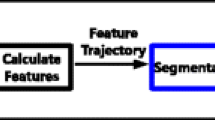Abstract
Trajectory segmentation is essential for various location-based applications. Most of the existing trajectory segmentation algorithms are designed for offline data, thus cannot segment trajectory streams efficiently. In this paper, we propose a novel and efficient streaming trajectory segmentation algorithm based on stay point detection. Our algorithm can dynamically update in real time based on input points, eliminating the need for scanning the entire trajectory. To enhance its suitability for streaming scenarios, we introduce a well-designed grid index and identify three areas based on it for calculation pruning. We conduct extensive experiments using three diverse datasets from different domains (ranging from taxis to trucks to pedestrians), which verifies the efficiency of our method.
Access this chapter
Tax calculation will be finalised at checkout
Purchases are for personal use only
Similar content being viewed by others
Notes
- 1.
The merged stay point may not satisfy the distance constraint, but it does not affect the correctness of segmentation. On the contrary, it can simplify the description.
- 2.
https://github.com/Spatio-Temporal-Lab/StreamingTrajSegment.
References
Cui, Z., Henrickson, K., Ke, R., Wang, Y.: Traffic graph convolutional recurrent neural network: a deep learning framework for network-scale traffic learning and forecasting. IEEE Trans. Intell. Transp. Syst. 21(11), 4883–4894 (2019)
Etemad, M., Júnior, A.S., Hoseyni, A., Rose, J., Matwin, S.: A trajectory segmentation algorithm based on interpolation-based change detection strategies. In: EDBT/ICDT Workshops, pp. 58 (2019)
Etemad, M., Soares, A., Etemad, E., Rose, J., Torgo, L., Matwin, S.: SWS: an unsupervised trajectory segmentation algorithm based on change detection with interpolation kernels. GeoInformatica 25(2), 269–289 (2020). https://doi.org/10.1007/s10707-020-00408-9
He, H., et al.: TraSS: efficient trajectory similarity search based on key-value data stores. In: ICDE, pp. 2306–2318. IEEE (2022)
He, H., Xu, Z., Li, R., Bao, J., Li, T., Zheng, Y.: TMan: a high-performance trajectory data management system based on key-value stores. In: ICDE, pp. 4951–4964. IEEE (2024)
Li, R., et al.: Discovering real-time reachable area using trajectory connections. In: Nah, Y., Cui, B., Lee, S.-W., Yu, J.X., Moon, Y.-S., Whang, S.E. (eds.) DASFAA 2020. LNCS, vol. 12113, pp. 36–53. Springer, Cham (2020). https://doi.org/10.1007/978-3-030-59416-9_3
Li, R., et al.: TrajMesa: a distributed NoSQL-based trajectory data management system. IEEE Trans. Knowl. Data Eng. 35(1), 1013–1027 (2021)
Li, R., et al.: TrajMesa: a distributed NoSQL storage engine for big trajectory data. In: 2020 IEEE 36th International Conference on Data Engineering (ICDE), pp. 2002–2005. IEEE (2020)
Li, R., et al.: Efficient path query processing over massive trajectories on the cloud. IEEE Trans. Big Data 6(1), 66–79 (2018)
Li, R., Ruan, S., Bao, J., Li, Y., Wu, Y., Zheng, Y.: Querying massive trajectories by path on the cloud. In: ACM SIGSPATIAL, pp. 1–4 (2017)
Li, R., Zhu, H., Wang, R., Chen, C., Zheng, Y.: Fast and distributed map-matching based on contraction hierarchies. J. Comput. Res. Devel. 59(2), 342–361 (2022)
Markos, C., James, J., Da Xu, R.Y.: Capturing uncertainty in unsupervised GPS trajectory segmentation using Bayesian deep learning. In: AAAI, vol. 35, pp. 390–398 (2021)
Resheff, Y.S.: Online trajectory segmentation and summary with applications to visualization and retrieval. In: Big Data, pp. 1832–1840. IEEE (2016)
Ruan, S., Li, R., Bao, J., He, T., Zheng, Y.: CloudTP: a cloud-based flexible trajectory preprocessing framework. In: ICDE, pp. 1601–1604. IEEE (2018)
Ruan, S., et al.: Discovering actual delivery locations from mis-annotated couriers’ trajectories. In: ICDE, pp. 3241–3253. IEEE (2022)
Zaman, B., Altan, D., Marijan, D., Kholodna, T.: Reactive buffering window trajectory segmentation: RBW-TS. J. Big Data 10(1), 123 (2023)
Zheng, Y.: Trajectory data mining: an overview. ACM Trans. Intell. Syst. Technol. (TIST) 6(3), 1–41 (2015)
Zheng, Y., et al.: GeoLife: a collaborative social networking service among user, location and trajectory. IEEE Data Eng. Bull. 33(2), 32–39 (2010)
Zheng, Y., Zhang, L., Ma, Z., Xie, X., Ma, W.Y.: Recommending friends and locations based on individual location history. ACM Trans. Web (TWEB) 5(1), 1–44 (2011)
Acknowledgment
This paper is supported by the National Natural Science Foundation of China (62202070, 62322601), China Postdoctoral Science Foundation (2022M720567) and the Excellent Youth Foundation of Chongqing (CSTB2023NSCQJQX0025).
Author information
Authors and Affiliations
Corresponding authors
Editor information
Editors and Affiliations
Rights and permissions
Copyright information
© 2024 The Author(s), under exclusive license to Springer Nature Singapore Pte Ltd.
About this paper
Cite this paper
Sun, Y., Meng, F., Li, R., Tang, Y., Chen, C., Zhong, J. (2024). Streaming Trajectory Segmentation Based on Stay-Point Detection. In: Onizuka, M., et al. Database Systems for Advanced Applications. DASFAA 2024. Lecture Notes in Computer Science, vol 14850. Springer, Singapore. https://doi.org/10.1007/978-981-97-5552-3_13
Download citation
DOI: https://doi.org/10.1007/978-981-97-5552-3_13
Published:
Publisher Name: Springer, Singapore
Print ISBN: 978-981-97-5551-6
Online ISBN: 978-981-97-5552-3
eBook Packages: Computer ScienceComputer Science (R0)




